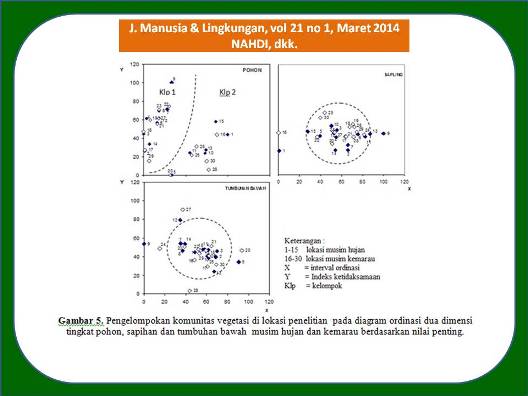
STRUKTUR KOMUNITAS TUMBUHAN DAN FAKTOR LINGKUNGAN DI LAHAN KRITIS, IMOGIRI YOGYAKARTA (Community Structure of Plant and Environmental Factor in Critical Land, Imogiri Yogyakarta)
Maizer Said Nahdi(1*), Djoko Marsono(2), Tjut Sugandawaty Djohan(3), M. Baequni(4)
(1) Fakultas Sains dan Teknologi, Universitas Islam Negeri Sunan Kalijaga, Yogyakarta
(2) Fakultas Kehutanan, Universitas Gadjah Mada, Bulaksumur, Yogyakarta 55281
(3) Fakultas Biologi, Universitas Gadjah Mada, Sekip Utara, Yogyakarta 55281
(4) Fakultas Geografi, Universitas Gadjah Mada, Sekip Utara, Yogyakarta 55281
(*) Corresponding Author
Abstract
ABSTRAK
Penelitian bertujuan mempelajari struktur komunitas tumbuhan pada berbagai tingkat pertumbuhan sebagai respon terhadap aktivitas masyarakat, dan kualitas fisik kimia tanah yang terbentuk di kawasan lahan kritis Imogiri. Metode penelitian menggunakan kuadrat plot, dengan ukuran plot 1x1, 5x5, 10x10, ulangan 6 – 10 diletakkan secara stratified random sampling. Pengumpulan data dengan mengamati kehadiran cacah spesies, dihitung kerapatan, dominansi, frekuensi spesies, dan Nilai Penting. Analisis ordinasi dua dimensi digunakan untuk mengelompokkan komunitas pada berbagai tingkat pertumbuhan, dengan analisis t-test untuk uji signifikansi unsur fisik kimia tanah. Hasil penelitian ditemukan 303 spesies, terdiri dari 34 tingkat pohon, 62 sapling dan 207 tumbuhan bawah dengan distribusi yang bervariasi. Kemelimpahan menunjukkan bahwa pada tingkat pohon terjadi pengelompokan, sedangkan pada tingkat sapling dan tumbuhan bawah mengumpul menjadi satu. Dalbergia sisso tingkat pohon dan sapling serta tumbuhan bawah Euphatorium inulifolium merupakan spesies paling dominan dan merespon kondisi lahan kritis sehingga dapat dijumpai pada semua lokasi kajian. Kemelimpahan tingkat pohon sangat dipengaruhi oleh aktivitas masyarakat, dan mineral organik yang terbentuk sehingga didominasi vegetasi dengan nilai ekonomi tinggi. Sedangkan kehadiran spesies tingkat sapling dan tumbuhan bawah merespon kandungan hara yang terbentuk.
ABSTRACT
The purpose of this research was to study the community structure of plant at different growth-forms in response to the activities of the local community (people) and the physico-chemical characteristics of soil in the critical land of Imogiri. The research methods employed random quadrat with plot size of 1 x 1, 5 x 5, 10 x 10 m. The placement of the plot followed stratified random sampling. At each plot, species richness, density, dominance, frequency of species, importance values were calculated. The grouping of growth-forms was analyzed using Ordination Analysis and t-test was used to find out the significance of physico-chemical characteristics of the soil. The finding suggested that 303 species could be found in Imogiri, consisting of 34 trees, 62 saplings, and 207 seedlings. Based on the calcultation of the species abundance, it could be concluded that there was an unequal pattern of vegetation communities at the level of trees, saplings, and seedlings/ shrubs. At the level of tree, grouping could be found. Meanwhile at the level of tree, sapling and seedlings tend to show one group (clumped). The tree and sapling of Dalbergia sisso and the shrub of Euphatorium inulifolium showed high dominance and responded the critical land very well hence they could be found in almost in all locations. The abundance of tree species was highly influenced by people’s activities and organic minerals that occur in the area. Hence, most of trees had high economical value. Meanwhile, the presence of species at the level of sapling and seedling responded the occuring soil-nutrients.
Keywords
Full Text:
Artikel lengkap (PDF) (Bahasa Indonesia)References
Abas, I. A. Y., Soeleman dan A. Abdurahman. 2003. Keragaman dan Dampak Penerapan Sistem Usaha Tani Konservasi terhadap Tingkat Produktivitas Lahan Perbukitan Yogyakarta. Jurnal Litbang Pertanian, 22(2): 49-55 Cramb, R. A. 2004. Farmers Strategies for Managing Acid Upland Soils in Southeast Asia: An Evolutionary Perspective. Agriculture, Ecosystem and Environment, 106(1): 69-74 Fitter, A. H. dan R. K. M. Hay. 1992. Fisiologi Lingkungan Tanaman (penerjemah Sri Andayani dan Purbayanti). Gamapress. Yogyakarta Ford, D.C., dan Williams, P. 2007, Karst Hydrogeology and Geomorphology. John Wiley & Sons. Chichester Foth, H. D.1991. Fundamentals of Soil Science. 8th edition, John Wiley & Sons. New York Handayani, I. P. dan P. Prawito. 2005. Tumbuhan Perintis Pemulih Lahan Kritis, Kiat petani Membangun Kesuburan Tanah. Yayasan KEHATI. Jakarta Jan, L. & P. Smilauer. 1999. Multivariate Analysis of Ecological Data. Faculty of Biological Sciences, University of South Bohenia. Ceske Budejovice, pp.27-30 Kurniawan, A. dan Parikesit, 2008, Persebaran Jenis di Sepanjang Faktor Lingkungan di Cagar Alam Penanjung Pangandaran, Jawa Barat. Biodiversitas, 9(4). Mahler, B. J., D. Valdes, M. Musgrove dan N. Massei. 2008. Nutrient Dynamic as Indicators of Karst Processes:Comparison of The Chalk Aquifier (Normandy, France) and the Edward Aquifer. Contam. Hidrol., 26(1): 36-49 Mueller-Dombois, D. dan H. Ellenberg. 1974. Aims and Methods of Vegetation Ecology. John Wiley & Sons. New York Ni, X., R. Liu, S. Wang dan J. Liu. 2004. Spectral Characteristics of Karst Vegetation in Southwest China. Institute of Geochemistry, Chinese Academy of Sciences. China Notohadiprawiro, T. 1996. Lahan Kritis dan Bincangan Pelestarian Lingkungan Hidup. Seminar Nasional Penanganan Lahan Kritis di Indonesia, UGM. Yogyakarta Satari, G., S. Sajad dan S. Sastrosudarjo. 1977. Pendayagunaan Tanah Kering Untuk Budidaya Tanaman Pangan: Menjawab Tantangan Tahun 2000. Kongres Agronomi. Jakarta Suryatmojo, H. 2006. Strategi Pengelolaan Ekosistem Karst di Kabupaten Gunung Kidul. Yogyakarta: Seminar Nasional Strategi Rehabilitasi Kawasan Konservasi di Daerah Padat Penduduk Fak Kehutanan UGM. Yogyakarta.
Article Metrics
Refbacks
- There are currently no refbacks.
Copyright (c) 2017 Jurnal Manusia dan Lingkungan







